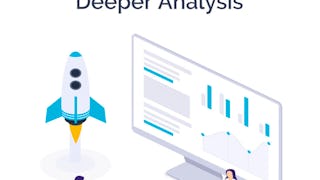This course focuses on the techniques you can use to provide Internet access through BGP. You will gain an understanding of customer-to-provider connectivity requirements and learn how to provide Internet connectivity for customers who are attached to a single or multiple service providers. Finally, you will learn how to scale the IGP and BGP in a service provider network.

Heat up your career this summer with courses from Google, IBM, and more for £190/year. Save now.


Providing Customers Internet Connectivity using BGP
This course is part of Configuring BGP on Cisco Routers Specialization

Instructor: Cisco Learning & Certifications
Included with 
Skills you'll gain
Details to know

Add to your LinkedIn profile
July 2025
37 assignments
See how employees at top companies are mastering in-demand skills

Build your subject-matter expertise
- Learn new concepts from industry experts
- Gain a foundational understanding of a subject or tool
- Develop job-relevant skills with hands-on projects
- Earn a shareable career certificate

There are 6 modules in this course
What's included
2 readings
Customers connect to the Internet by using service providers to enable applications such as intranet connectivity with VPNs, extranet connectivity with suppliers, and other Internet applications. When you plan network connectivity to an ISP, you as a network designer must give careful consideration to the various aspects of the connectivity. These aspects include physical connection types, the redundancy that the chosen connection method provides, IP addressing requirements, and AS numbering considerations if the network design will meet both business and technical requirements of the applications that are planned for the network. In this course, you will learn solutions for connecting customer networks to service providers. You will also learn customer network redundancy requirements, routing requirements, IP addressing requirements, and AS numbering requirements.
What's included
5 videos7 readings7 assignments
When a customer can connect to the Internet through either a single connection to a service provider or through multiple connections to the same ISP, static routing is the simplest routing approach to implement between the customer and provider. When network administrators are implementing customer-to-provider connectivity with static routes, knowledge of static routing implementation guidelines will aid in successfully deploying static routing network configurations.
What's included
6 videos7 readings7 assignments
When multiple connections to the same service provider is the only way that a customer can connect to the Internet, the connections must be correctly configured. They must ensure proper interaction between the customer and the service provider network. You must understand how to configure routing protocols so that customer backup or load-balancing requirements are met. In this course, you will learn about the use of multiple connections between a customer and a single ISP for backup and load-sharing purposes.
What's included
10 videos10 readings10 assignments
A customer that requires the maximum redundancy in its network design should implement a multihomed strategy that uses multiple service providers. This configuration requires specific considerations to be implemented properly. Addressing and AS number selection are important considerations that affect the network implementation. Routing protocols must be configured correctly so that customer backup or load-sharing requirements are met. In this course, you will learn about multiple connections between a customer and multiple service providers for backup and load-sharing purposes, including the BGP characteristics that are used to configure such connectivity. You will also learn about address selection, private AS number translation, and configuration of the network to support either backup links or load sharing.
What's included
7 videos9 readings8 assignments
All service providers are concerned about properly scaling IP addressing, IGPs, and BGP. It can be the difference between a successful and a problematic BGP implementation. Service provider networks are complex and must meet the administrative policy and routing demands of the internal network, different customers, and other providers. Proper scaling is crucial to the success of the network. Interactions between IGPs and the BGP can be quite complex, specifically when you support internal routing, customer connectivity, and transit traffic (and the administrative policies that match). Furthermore, the large number of prefixes that are required to support full Internet routing requires administrators to fully characterize IGP and BGP interactions for internal networks and customers alike. This course discusses network scalability concerns common to large, complex service provider networks. This course includes a description of a typical ISP network and discussion of the propagation of internal and customer routing information. This course also describes scaling considerations for IGPs and BGP, and scaling of IP addressing in service provider networks.
What's included
4 videos5 readings5 assignments
Earn a career certificate
Add this credential to your LinkedIn profile, resume, or CV. Share it on social media and in your performance review.
Instructor

Offered by
Explore more from Networking
 Status: Free Trial
Status: Free TrialGoogle Cloud
 Status: Free Trial
Status: Free Trial Status: Free
Status: FreeCoursera Project Network
Why people choose Coursera for their career





Open new doors with Coursera Plus
Unlimited access to 10,000+ world-class courses, hands-on projects, and job-ready certificate programs - all included in your subscription
Advance your career with an online degree
Earn a degree from world-class universities - 100% online
Join over 3,400 global companies that choose Coursera for Business
Upskill your employees to excel in the digital economy
Frequently asked questions
Access to lectures and assignments depends on your type of enrollment. If you take a course in audit mode, you will be able to see most course materials for free. To access graded assignments and to earn a Certificate, you will need to purchase the Certificate experience, during or after your audit. If you don't see the audit option:
The course may not offer an audit option. You can try a Free Trial instead, or apply for Financial Aid.
The course may offer 'Full Course, No Certificate' instead. This option lets you see all course materials, submit required assessments, and get a final grade. This also means that you will not be able to purchase a Certificate experience.
When you enroll in the course, you get access to all of the courses in the Specialization, and you earn a certificate when you complete the work. Your electronic Certificate will be added to your Accomplishments page - from there, you can print your Certificate or add it to your LinkedIn profile. If you only want to read and view the course content, you can audit the course for free.
If you subscribed, you get a 7-day free trial during which you can cancel at no penalty. After that, we don’t give refunds, but you can cancel your subscription at any time. See our full refund policy.
More questions
Financial aid available,


